With hearing loss, activities like watching TV can become difficult, not only for the person who is hearing impaired but also for the other people in the home. To deal with hearing loss, many people turn up the volume on their television to a level that others in the household find challenging to live with.
An easy and inexpensive solution to this problem is to get a listening system that allows one person to listen to the TV at an amplified volume through headphones or a speaker, while others in the household can listen at a more comfortable level.
Some of the TV speakers that have become available in the last few years have changed the game as far as the quality of the voice amplification on your TV. They are using the latest hearing aid technology and are well worth a look, especially the ZVOX Accuvoice.
| Product | Rank | Type | Price | Review | |
|---|---|---|---|---|---|
| ZVOX AccuVoice AV200 Sound Bar TV Speaker | #1 | Sound Bar Speaker | Check Pricing | Read the Full Review | |
| Sennheiser Flex 5000 | #2 | Radio Frequency | Check Pricing | Read the full review |  |
| Sennheiser SET840 | #3 | Radio Frequency/FM | Check Pricing | Read the Full Review | 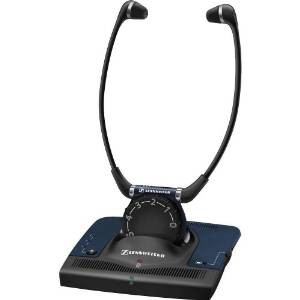 |
| Simolio Wireless TV Headset | #4 | 2.4GHz Digital Automatic FHSS | Check Pricing | 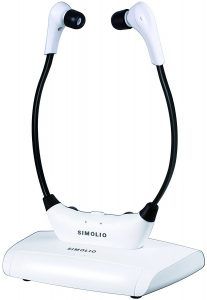 |
|
| TV Ears Digital Wireless Headset System | #5 | Infrared Systems | Check Pricing | 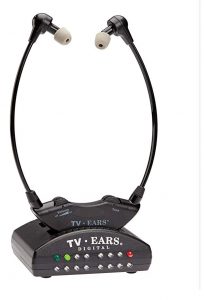 |
|
| TV SoundBox® Wireless TV Speaker Model TV-SB | #6 | Radio Frequency/FM | Check Pricing | Read the Full Review | 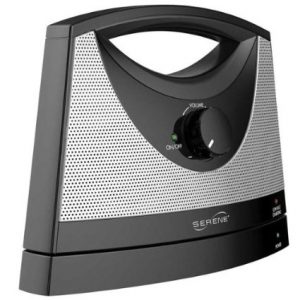 |
| Audio Fox Wireless TV Speakers | #7 | Radio Frequency/FM | Check Pricing | Read the Full Review | 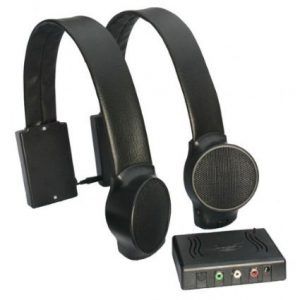 |
There are some great systems available to choose from depending on how much you are willing to spend and the type of devices that you find comfortable using.
This guide covers:
- Types of TV listening devices for the hearing impaired
- What model is best for your level of hearing loss
- Wearing Style
- Features
- Cost/Budget
Types of TV Listening Devices

If you are shopping for a device to help you hear your television more clearly, you will come across some different options, each with its pros and cons. Understanding the differences between the devices can be a challenge. The most popular technology or systems that you can use to help the hard of hearing watch television are:
- Soundbars with hearing aid technology to clarify voices
- Infrared Systems
- FM radio frequency systems
- Induction Loops
Soundbars
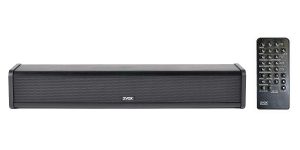
Soundbars, in general, have become very popular with the rise in flat-screen TVs. Many flat-screen models don’t have good sound quality, making it difficult to hear voices. This is an issue for the general population, not just for those with hearing loss.
One product that is very popular for individuals with hearing loss is ZVOX and its soundbars and sound bases. What makes the ZVOX products so useful for the hearing impaired is their AccuVoice technology that uses hearing aid technology to lift voices out of the overall sound coming from the TV, making them easier to comprehend.
Companies/Brands: ZVOX, TV Ears
PROS:
- Moderately priced
- Easy to set-up
- Easy to use
- Most find the level of improvement on the clarity of dialogue to be substantial.
CONS:
- Depending on the model you get, it may not work well for severe hearing loss
Price Range: $150- $250+
Read More: Best TV Soundbars for Hearing Impaired
Infrared systems
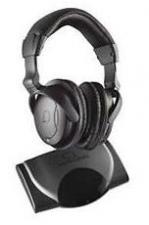
Infrared systems are often used in the home with television sets, although they can also be used in large settings like theaters. The way that they work is a small transmitter converts the sound that is coming from your TV into invisible infrared light waves that are transmitted to your receiver (a headset or small speaker ) that turns the light back into high fidelity stereo sound that goes directly into your ears. You can then adjust the sound to your desired volume. You can use this type of system with or without a hearing aid.
IR systems plug directly into the audio output of a TV set. For older sets with no outputs, most systems feature optional microphones that users may place next to the speaker of the TV.
The main difference between Infrared and FM systems is that infrared light is unable to pass through walls, so they are particularly useful for situations with multiple systems operating in different rooms like a courtroom, boardrooms, or a multiplex theatre, or where confidentiality is essential.
Companies/Brands: Able Planet, Clear Sounds, Sennheiser, Serene Innovations, TV Ears
PROS:
- Compared to a hearing aid they are relatively economical
- Privacy, the transmission of IR is confined within the walls of a room.
- Best for multiple occupancy residences
- Some experts believe that IR produces the best sound quality.
- IR wireless systems are immune to radio interference.
CONS:
- The receivers are susceptible to sunlight interference, so you can’t use them outside if it is sunny. Although this isn’t usually a problem when watching TV.
- Most systems require hookup to the main outlet, which may limit portability.
- Shadows or blockages of either the transmitter or receiver can interfere or cut out the transmission. So you must have a direct line of sight between the transmitter and receiver (it works similarly to remote control).
- Generally requires the use of a special headset
Price Range: $40- $200+
Read More: Best TV Speakers for Hard of Hearing
Read More: Best TV Headphones for the Hearing Impaired
Radio Frequency/FM System

Radio Frequency/FM listening systems transmit sound via radio waves that can go through walls and ceilings, so you can keep listening to the TV in any room. The personal FM system consists of a transmitter microphone that is attached to the television and a receiver, usually in the form of a headset or a neck loop.
The receiver transmits the sound directly to your ears or, if you wear a hearing aid, to the hearing aid.
Companies/Brands: Audio Fox, Sennheiser, Serene Innovations, William Sound
PROS:
- An FM system is generally straightforward to set up and highly portable.
- Since radio signals travel through walls, you can continue to listen to the TV if you have to leave the room.
- It can be used indoors or outdoors.
- Economical compared to the cost of a hearing aid.
CONS:
- Generally requires the use of a special headset
- If you are worried about security, FM systems are susceptible to interference and can be discreetly intercepted. It isn’t a huge concern if you are watching television, the security concerns are more relevant for people who are using FM systems in boardrooms or courtroom type situations.
- You need to tune the receiver. To clarify reception, users may have to switch channels in the middle of a particular program due to poor reception.
- Prone to interference from other FM wireless systems.
Price Range: $100 to $300 +
Induction loops

If you use a hearing aid, you might already be familiar with loop systems. A hearing loop picks up the sound of a speaker’s voice (or another source like a television) from a microphone (or wired connection) and transmits the sound directly to a listener’s hearing aid equipped with a T-coil. The listener can pick up the audio when they are within the loop. Loop systems allow background noise to be eliminated while the speaker’s voice is amplified. These are fantastic devices for people who use hearing aids that are equipped with telecoils. Loop systems are primarily used by people with hearing t-coil equipped hearing aids, but in some cases, people who don’t use hearing aids can use a loop system if they purchase a particular receiver (usually a type of headphone that will pick up the signal.)
Companies/Brands: Audio Fox, Sennheiser, Serene Innovations, William Sound
PROS:
- Require purchasing/maintaining/replacing fewer portable receiving units (for those without T-coils).
- They use a universal magnetic signal, which works no matter the location or hearing instrument brand
- Inconspicuous
- Hearing-aid compatible. There’s no need to juggle between hearing aids and headsets.
CONS:
- You have to set up the loop in a fixed space; the loops cannot quickly be moved to another room
- The signal strength is limited to the area of the loop. If you have to leave the room while you are watching TV, you probably won’t still be able to hear what you are viewing.
- Loop systems can have interference from other electronics, which may result in a buzzing sound in the user’s hearing aid.
Price Range: $150 – $300
MORE: Best Induction Loops
What type of device is best for your level of hearing loss
Listening systems are useful for all types of hearing loss. You can use them with or without hearing aids. The leading technologies used are Soundbars with hearing aid technology, FM, infrared, or inductive loop technologies. All are considered useful, and each has advantages and disadvantages depending on the level of hearing loss.
Soundbars work very well for almost everyone,
FM systems use radio broadcast technology that can go through walls and ceiling, so they tend to be good options if you move around a lot and still want to keep listening while in another room.
Infrared systems guarantee privacy because light does not pass through walls. They are the best choice for situations such as court proceedings that require confidentiality or residential complexes where there might be high wireless usage and will have the least amount of interference from other devices.
Inductive Loop Systems are the best option for anyone with a telecoil-equipped hearing aid who needs assistance with overall clarity of sound and help with minimizing background noise. Non-hearing aid users use loop systems through the use of a headphone and inductive loop receiver.
Wearing Style
Television Listening systems have some different wearing styles, although most are just variations of headset styles. The main styles you will come across are:
- Earphones/headphones – This is probably the most familiar style. They are the regular headphones that are placed over the ear to listen, without other people hearing.
- Neckloop Listeners – are what you would wear around your neck if you have hearing aids with t-coils. The neck loop wirelessly sends sound into your hearing aids. The t-coils in your hearing aids act like little speakers in your ears.
- Stethoscope Listeners -Lightweight and comfortable headphones that hang beneath your ears. These are not suitable for hearing aid wearers.
Features
With the different types of devices, there are some features that you will want to be aware of when you are purchasing these types of systems.
Volume Control – Being able to modify the volume of the device is a must-have feature to ensure that you can customize the device to your specific hearing level. Almost all devices will have this control.
Range – Some systems will give you a range of up to 45 m. For most television watching situations, a range of between 10-20 m should be sufficient.
Bluetooth -There are a couple of listening systems with Bluetooth that let you pair your TV and Bluetooth cell phone to the listener, so you can take calls with your listener headset and switch back to the television when your call ends. If you are interested in this, have a look at the Clearsounds Bluetooth TV and Audio Listening System.
Hearing Aid /Telecoil Compatibly – For anyone with hearing aids fitted with telecoils many hearing-aid-compatible IR TV listening systems feature receivers designed to connect directly to your hearing aid, or an installed induction loop. Other IR systems feature neck loops that broadcast a signal directly to telecoil-equipped hearing aids.
Transmitter – All of these devices to help you watch TV have a transmitter that usually requires a power source. Most transmitters are quite small, and you shouldn’t need a lot of space to store them. They are most commonly plugged directly into the back of the television.
Receiver – The receiver is what is worn by the listener. The receiver can be a hearing aid, headset (headphones), neck loop, or bodypack. Generally, they have rechargeable batteries that charge when the device is not in use and placed back on the transmitter charging cradle.
Headphones – A lot of the listening systems have a wireless headphone that is battery-powered, and the transmitter generally serves as the battery charger, as well as the place where you would store your wireless headphones. If the headphones are wireless, it is a good idea to check how long is the operating time and the charging time for the headsets.
Warranty – Most systems come with at least a one-year manufacturer warranty. Since hearing is so subjective, you may find you get a system that a lot of people like but it isn’t right for you and you will want to return it, so it’s important
Cost/Budget
To get a decent system, you are looking at the cost of somewhere between $150 to $300, although there are a few budget options available.
Under $50
Unisar J3 Listener Wireless Headset is a good value for the money despite having a limited range. If you are on a budget, the Unisar is worth checking out.
$100 to $200
Most of the TV listening systems fall into this price range, so this is where you will have the most selection. An excellent place to start is with the Sennheiser Flex 5000 Digital Wireless Headphones; they are a new wireless headphone system that is getting great reviews and appear to work well for watching TV. The best option is the ZVOX Accuvoice that is listed above. You could also have a look at the Wireless TV Listening Speaker, which is a speaker that you place beside you when you are watching TV, so no headphones necessary. Another no headphones option in this price range that is very popular is the ZVOX AccuVoice AV200 Sound Bar TV Speaker.
$200 to $300
In this price range, you are getting very high quality with top features. You will find the Audio Fox Wireless TV Speakers in this price range that is different than most of the other designs and would be a good option for someone who doesn’t like wearing headphones. If you don’t mind wearing headphones, a good choice is the Sennheiser SET840.
- The Best Hearing Amplifiers of 2021 - October 23, 2020
- Best TV Soundbars for Hearing Impaired - October 23, 2020
- Hearing Devices to Help People in Nursing Homes and Hospitals - October 23, 2020
